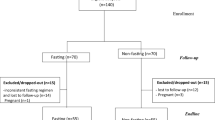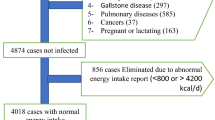Abstract
Background/Objectives:
Changes in food consumption patterns during Ramadan may cause metabolic changes, but these have not been well studied. We aimed to determine food intake, glucose homeostasis, lipid profiles, and body composition before, during, and after Ramadan fasting.
Methods
160 healthy men were enrolled and investigated at three times (before, at the end of, and 1 month after Ramadan). Body composition was estimated by bio-impedance. Fasting blood samples were obtained for measuring fasting blood sugar (FBS), lipid profiles and insulin level. Insulin resistance (IR) was identified by the homeostatic model assessment (HOMA) of peripheral IR. Food intake was measured using a validated food frequency questionnaire before and during Ramadan. Statistical analysis was performed by SPSS 16 and P < 0.05 considered the level of significance.
Results
Anthropometric parameters such as body weight, body mass index, and body fat percentage (BFP) as well as FBS and circulating triglycerides were all decreased significantly at the end of Ramadan compared with the same indices measured prior to Ramadan (all P < 0.001). In contrast, at the end of Ramadan, HOMA-IR was significantly elevated (P < 0.001). One month after Ramadan, these traits had all started to return to their pre-Ramadan levels, but were still disrupted. Food intake of all food groups except carbohydrates were decreased during Ramadan.
Conclusion
Ramadan fasting may lead to both positive and negative health effects such as a decrease in FBS, weight, BFP, and increase in LDL and IR in healthy adults. However, these effects were all transitory.
This is a preview of subscription content, access via your institution
Access options
Subscribe to this journal
Receive 12 print issues and online access
$259.00 per year
only $21.58 per issue
Buy this article
- Purchase on Springer Link
- Instant access to full article PDF
Prices may be subject to local taxes which are calculated during checkout


Similar content being viewed by others
References
Bakhotmah BA. The puzzle of self-reported weight gain in a month of fasting (Ramadan) among a cohort of Saudi families in Jeddah, Western Saudi Arabia. Nutr J. 2011;10:1–8.
Trepanowski JF, Bloomer RJ. The impact of religious fasting on human health. Nutr J. 2010;9:57 2891–9-57.
Richards EG. Mapping Time: The Calendar and its History.. Oxford: Oxford University Press; 1998. pp. 231–5.
Angel JF, Schwartz NE. Metabolic changes resulting from decreased meal frequency in adult male Muslims during the Ramadan fast. Nutr Rep Int J. 1975;11:29–38.
Rashed AH. The fast of Ramadan no problems of the well: the sick should avoid fasting. Br Med J Qatar. 1994;48:11–7.
Nugraha B, Ghashang SK, Hamdan I, Gutenbrunner C. Effect of Ramadan fasting on fatigue, mood, sleepiness, and health-related quality of life of healthy young men in summer time in Germany: a prospective controlled study. Appetite. 2017;111:38–45.
Sezen Y, Altiparmak IH, Erkus ME, Kocarslan A, Kaya Z, Gunebakmaz O, et al. Effects of Ramadan fasting on body composition and arterial stiffness. J Pak Med Assoc. 2016;66:1522–7.
Yeoh EC, Zainudin SB, Loh WN, Chua CL, Fun S, Subramaniam T, et al. Fasting during ramadan and associated changes in glycaemia, caloric intake and body composition with gender differences in Singapore. Ann Acad Med Singap. 2015;44:202–6.
López-Bueno M, González-Jiménez E, Navarro-Prado S, Montero-Alonso MA, Schmidt-RioValle J. Influence of age and religious fasting on the body composition of Muslim women living in a westernized context. Nutr Hosp. 2014;31:1067–73.
Reiches MW, Moore SE, Prentice AM, Ellison PT. Endocrine responses, weight change, and energy sparing mechanisms during Ramadan among Gambian adolescent women. Am J Hum Biol. 2014;26:395–400.
Norouzy A, Salehi M, Philippou E, Arabi H, Shiva F, Mehrnoosh S, et al. Effect of fasting in Ramadan on body composition and nutritional intake: a prospective study. J Hum Nutr Diet. 2013; Suppl 1: 97–104.
Maughan RJ, Bartagi Z, Dvorak J, Zerguini Y. Dietary intake and body composition of football players during the holy month of Ramadan. J Sports Sci. 2008;26:S29–38.
Hallak MH, Nomani MZ. Body weight loss and changes in blood lipid levels in normal men on hypocaloric diets during Ramadan fasting. Am J Clin Nutr. 1988;48:1197–210.
Harder-Lauridsen NM, Rosenberg A, Benatti FB, Damm JA, Thomsen C, Mortensen EL, et al. Ramadan model of intermittent fasting for 28 d had no major effect on body composition, glucose metabolism, or cognitive functions in healthy lean men. Nutrition. 2017;37:92–103.
Rohin MA, Rozano N, Abd Hadi N, Mat Nor MN, Abdullah S, Dandinasivara Venkateshaiah M. Anthropometry and body composition status during Ramadan among higher institution learning centre staffs with different body weight status. Sci World J. 2013; Article ID 308041, 7 pages.
Racinais S, Périard JD, Li CK, Grantham J. Activity patterns, body composition and muscle function during Ramadan in a Middle-East Muslim country. Int J Sports Med. 2012;33:641–6.
Hajek P, Myers K, Dhanji AR, West O, McRobbie H. Weight change during and after Ramadan fasting. J Public Health (Oxf). 2012;34:377–81.
Güvenç Alpay. Effects of ramadan fasting on body composition, aerobic performance and lactate, heart rate and perceptual responses in young soccer players. J Hum Kinet. 2011;29:79–91.
Ramadan J. Does fasting during Ramadan alter body composition, blood constituents and physical performance. Med Princ Pract. 2002;11:41–6.
Al Ati J, Beji C, Danguir J. Increased fat oxidation during Ramadan fasting in healthy women: an adaptative mechanism for body-weight maintenance. Am J Clin Nutr. 1995;62:302–7.
Dhurandhar NV, Schoeller DA, Brown AW, Heymsfield SB, Thomas D, Sørensen TI, et al. Energy Balance Measurement Working Group. Response to ‘Energy balance measurement: when something is not better than nothing’. Int J Obes (Lond). 2015;39:1175–6.
Nader Lessan, Ilham Saadane, Budour Alkaaf, Catherine Hambly, Nick Finer, John R. Speakman, et al. The Effects of Ramadan Fasting on Activity and Energy Expenditure (2017: Submitted).
Lamri-Senhadji MY, El Kebir B, Belleville J, Bouchenak M. Assessment of dietary consumption and time-course of changes in serum lipids and lipoproteins before, during and after Ramadan in young Algerian adults. Singapore Med J. 2009;50:288.
Hallak A, Nomani MZA. Body weight loss and changes in blood lipid levels in normal men on hypocaloric diets during ramadan fasting. Am J Clin Nutr. 1988;48:1197–210.
Unalacak M, Kara IH, Baltaci D, Erdem O, Bucaktepe PG. Effects of Ramadan fasting on biochemical and hematological parameters and cytokines in healthy and obese individuals. Metab Syndr Relat Disord. 2011;9:157–61.
Sadiya A, Ahmed S, Siddieg HH, Babas IJ, Carlsson M. Effect of Ramadan fasting on metabolic markers, body composition, and dietary intake in Emiratis of Ajman (UAE) with metabolic syndrome. Diabetes Metab Syndr Obes. 2011;4:409–16.
Mirmiran P, HosseiniEsfahani F, Azizi F. Relative validity and reliability of the food frequency questionnaire used to assess nutrient intake: Tehran lipid and glucose study. Iran J Diabetes Lipid Disord. 2009;9:185–97.
Wallace TM, Levy JC, Matthews DR. Use and abuse of HOMA modeling. Diabetes Care. 2004;27:1484–7.
Shariatpanahi ZV, Shariatpanahi MV, Shahbazi S, Hossaini A, Abadi A. Effect of Ramadan fasting on some indices of insulin resistance and components of the metabolic syndrome in healthy male adults. Br J Nutr. 2008;100:147–51.
Adlouni A, Ghalim N, Benslimane A, Lecerf JM, Saile R. Fasting during Ramadan induces a marked increase in high-density lipoprotein cholesterol and decrease in low-density lipoprotein cholesterol. Ann Nutr Metab. 1997;41:242–9.
Babaee AK, Ghasemi M, Tavakili H, Yoosefi A. Study of some biochemical parameters in male university students affected by Ramadan fasting. J Univ Khorasan shomali Med Sci. 2008;1:21–6.
Navaei L, Mehrabi Y, Azizi F. Changes in body weight, blood pressure, consumption pattern and biochemical parameters in dia-betic patients during fasting in Ramadan. Iran J Endocrinol Metab. 2001;3:125–32.
Larijani B, Zahedi F, Sanjari M, Amiri MR, Jalili RB, Adibi H, et al. The effect of ramadan fasting on fasting serum glucose in healthy adulths. Med J Malays. 2003;58:680.
Ziaee V, Razaei M, Ahmadinejad Z, Shaikh H, Yousefi R, Yarmohammadi L, et al. The changes of metabolic profile and weight during Ramadan fasting. Singapore Med J. 2006;47:409–14.
Scott TG. The effect of muslim fast of ramadan on routin laborator investigation. King Abdulaziz Med J. 1981;1:23.
Khogheer Y, Sulaiman MI, Al-Fayez SF Ramadan fasting state of controls. Ann Saudi Med 1987;7:5–6.
Catharine Ross A. Modern Nutrition in health and disease. 11th edn, Wolters Kluwer Health/Lippincott Williams & Wilkins. 2014.
Zareh M. Study of some biochemical parameters in male university students affected by Ramadan fasting. J Sabzevar Univ Med Sci. 2002;9:30–5.
Trepanowski JF, Bloomer RJ. The impact of religious fasting on human health. Nutr J. 2010;9:57.
Song Y, Manson JE, Tinker L, Howard BV, Kuller LH, Nathan L, et al. Insulin sensitivity and insulin secretion determined by homeostasis model assessment and risk of diabetes in a multiethnic cohort of women: the Women’s Health Initiative Observational Study. Diabetes Care. 2007;30:1747–52.
Acknowledgements
The current study was sponsored by the Vice Chancellery of Research & Technology Affairs at Kermanshah University of Medical Sciences, Kermanshah – Iran (Grant no. 91058). The authors are deeply grateful to all participants for their time and blood sample donation. The authors declare no conflicts of interest. Author contributions. Project design: SMN, JRS. Data collection: SMN, YP, SP, MD, PN, RM. Data analysis: SMN, RM, JRS. Writing paper. SMN, JRS.
Author information
Authors and Affiliations
Corresponding authors
Ethics declarations
Conflict of interest
The authors declare that they have no conflict of interest.
Electronic supplementary material
Rights and permissions
About this article
Cite this article
Nachvak, S.M., Pasdar, Y., Pirsaheb, S. et al. Effects of Ramadan on food intake, glucose homeostasis, lipid profiles and body composition composition. Eur J Clin Nutr 73, 594–600 (2019). https://doi.org/10.1038/s41430-018-0189-8
Received:
Revised:
Accepted:
Published:
Issue Date:
DOI: https://doi.org/10.1038/s41430-018-0189-8
This article is cited by
-
Impact of religious fasting on metabolic and hematological profile in both dyslipidemic and non-dyslipidemic fasters
European Journal of Clinical Nutrition (2022)
-
Religious Fasting of Muslim Patients After Metabolic and Bariatric Surgery: a Modified Delphi Consensus
Obesity Surgery (2021)
-
Effects of Ramadan fasting on lean body mass in the older people
European Geriatric Medicine (2020)
-
A systematic review, meta-analysis, and meta-regression of the impact of diurnal intermittent fasting during Ramadan on body weight in healthy subjects aged 16 years and above
European Journal of Nutrition (2020)



